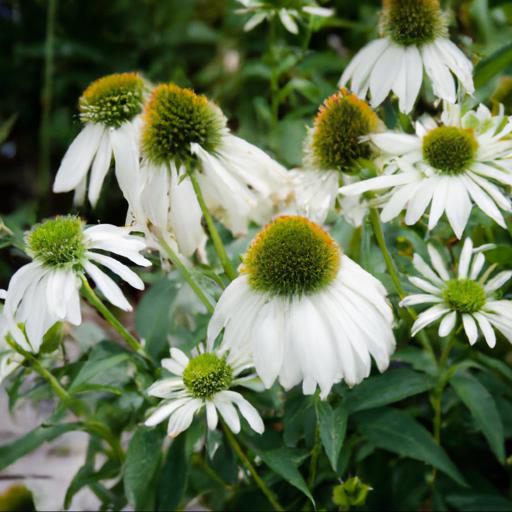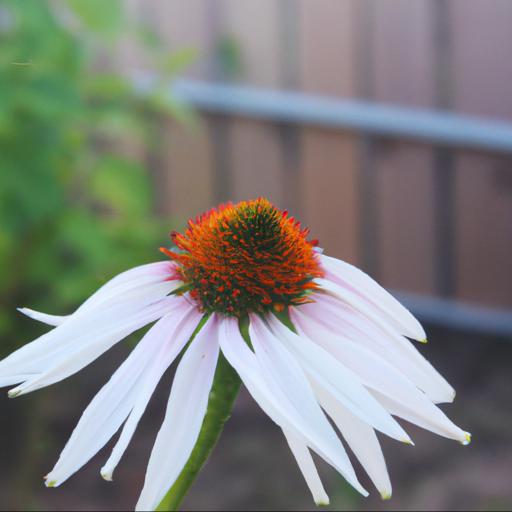Echinacea purpurea White Swan is a popular herb that has been used for centuries by Native Americans for its medicinal properties. It is believed to have anti-inflammatory and immune-boosting properties, and is commonly used to treat colds, flu, and other respiratory infections.
Echinacea purpurea White Swan is an easy-to-grow, hardy perennial that blooms with beautiful white flowers in late summer. It is an excellent choice for a medicinal herb garden, as it can be harvested and used fresh or dried. In this blog, we will explore the many benefits of Echinacea purpurea White Swan and how it can be used to improve your health and wellbeing.
Benefits of echinacea purpurea white swan

Echinacea purpurea white swan, commonly known as the purple coneflower, is an herbaceous perennial plant in the family Asteraceae. It is native to the United States and is widely used for medicinal purposes.
The plant produces a pink or purple flower with an egg-shaped cone at the centre. The leaves and roots of the plant are used to make teas, infusions, capsules and tinctures. Echinacea purpurea has numerous benefits.
It is believed to support the immune system and respiratory health, as well as being a potential aid to relieving minor pain. Studies have shown that it can help reduce inflammation and boost overall immunity. It can also stimulate the production of white blood cells, which are essential for fighting infections.
Additionally, there is some evidence that echinacea purpurea contains compounds that can aid in the prevention of certain illnesses and may even reduce the symptoms of common colds. Echinacea purpurea is easy to grow, making it a great choice for home gardeners.
Its flowers are hardy and will withstand cold temperatures, while its leaves turn a deep green colour during the summer months. The plant blooms late in the year, producing an abundance of vibrant purple flowers. The plant is also highly drought-tolerant and can tolerate some frost.
With its low-maintenance needs and its many potential health benefits, Echinacea purpurea is a great addition to any garden.
How to grow echinacea purpurea white swan

The white swan echinacea purpurea variety is an eye-catching perennial flower that will provide weeks of interest in every garden. Native to North American prairies, this herbaceous perennial is known for colorful daisy-like flowers in a striking white colour.
That is why it is also known as the White Swan coneflower. These flowers appear in late summer and continue to bloom until the first frost of autumn. In the meantime, you can enjoy bees, butterflies, hummingbirds, or goldfinches coming to these white blooms in search of nectar.
The flowers consist of a rosy-purple disc surrounded by broad, white rays and have a cheerful appearance that will brighten up any landscape. This echinacea variety is easy to grow and will thrive in full sun or partial shade in any well-drained soil that is not too acidic. It is also very tolerant of drought and will not demand too much attention.
Once planted, white swan echinacea purpurea can grow up to 60 cm (2 feet) tall with a spread of around 45 cm (18 inches). To extend the flowering period, be sure to deadhead dying blooms on a regular basis.
It is also possible to collect and sieve the seed to propagate new plants. For those looking to add a touch of cheer to their garden, the white swan echinacea purpurea is the perfect choice.
Long-lasting blooms, easy-to-grow habit, and a majestic, white color make this coneflower a must-have for any garden enthusiast.
How to use echinacea purpurea white swan

Echinacea purpurea, or ‘white swan’, is one of the few flowering plants that have been known to have immune-modulating properties. Native Americans have long used it to treat ailments, from the common cold to headaches, cuts, and diarrhoea. It is a spray of slender, smooth stems and is quite showy when in bloom, with its pure white petals and bright purple centres.
The constituents of echinacea, such as alkylamides, polyphenols, and essential oils, are essential to its medicinal properties. Some of these compounds have anti-inflammatory, anti-fungal, antiviral, and anti-bacterial functions.
By taking echinacea, an individual can strengthen their immune system and ward off a variety of ailments. As a gardener, it’s important to know how to care for echinacea purpurea white swan.
It is best to plant the seeds in either the autumn or spring depending on your climate. Ensure rich soil and partial sun when planting. Water the plant consistently, but avoid over-watering, as this can cause root rot.
Finally, make sure to deadhead any dead flowers, as this will encourage new growth. Ultimately, echinacea purpurea white swan has been used for centuries in herbal medicine, and is known for its immunity-enhancing properties. It is a showy garden flower, with its white petals and vibrant purple centres.
When taking echinacea, it is important to remember some key care tips: plant in autumn or spring, in rich soil and partial sun, water consistently but avoid overwatering, and deadhead any dead flowers. With the proper amount of care, gardeners can enjoy the multiple benefits of this herb in their very own backyard.
Common questions about echinacea purpurea white swan
Echinacea purpurea White Swan is a popular, long-flowering perennial flower that’s been growing in gardens around the world for centuries. A native of the United States, Echinacea purpurea White Swan is known for its vibrant, white petals and dramatic, daisy-like appearance.
With a long blooming season, it’s the perfect choice for your summer garden and is easy to care for. Echinacea purpurea White Swan grows in an attractive mounded shape, reaching heights of three feet or more in a single season. It’s hardy and drought-tolerant, making it a great choice for low-maintenance gardeners.
It prefers moist, well-drained soil in full sun but will also tolerate partial shade and can tolerate frost down to -30°F. Its large, deep-green foliage provides a beautiful background for the striking white blooms.
Echinacea purpurea White Swan is a sight to behold in the summer months when it’s in full bloom. Its large, daisy-like flowers are the star of the show, standing out against the deep-green foliage backdrop. The pure white petals stand atop an orange center, while the large, leafy bracts give the flowers a unique look.
This flower loves bees and butterflies and can attract a wide variety of pollinators to your garden. Once the flowers are spent, the seed heads are also a beautiful addition to the garden.
Echinacea purpurea White Swan is a long-lasting choice for the summer garden. Trim back the spent flowers and old foliage during the fall to encourage new growth in the spring. With its long blooming season and easy care requirements, it’s a great choice for any garden!
Our video recommendation
Final Touch
Echinacea purpurea White Swan is a popular species of echinacea, known for its white petals and long-lasting blooms. This perennial flower is easy to grow and makes a beautiful addition to any garden. It is a great choice for pollinators, providing nectar for bees and butterflies.
Echinacea purpurea White Swan is a low-maintenance flower that is drought-tolerant and can be grown in a variety of soils. With its beautiful white petals and long-lasting blooms, Echinacea purpurea White Swan is a great choice for gardeners looking for a hardy, low-maintenance flower.
FAQ
What are the medicinal benefits of Echinacea purpurea white swan?
Echinacea purpurea white swan has many medicinal benefits, including boosting the immune system, fighting inflammation, reducing cold and flu symptoms, and treating skin conditions. It is also used to treat upper respiratory infections, urinary tract infections, and other infections.
How does Echinacea purpurea white swan compare to other varieties of Echinacea?
Echinacea purpurea White Swan is a unique variety of Echinacea that has larger and more fragrant flowers than other varieties. It also has a longer flowering period and is more tolerant of drought and heat.
What is the best way to grow Echinacea purpurea white swan?
The best way to grow Echinacea purpurea White Swan is to plant it in well-drained soil in a sunny spot and water it regularly. It is also important to fertilize the plant regularly and to deadhead the flowers to encourage more blooms.
What are the most common uses of Echinacea purpurea white swan?
The most common uses of Echinacea purpurea white swan are to boost the immune system, reduce inflammation, and treat colds, flu, and other respiratory infections.
How long does it take for Echinacea purpurea white swan to reach maturity?
It typically takes Echinacea purpurea white swan plants between 2 and 3 years to reach maturity.
What is the optimal soil type for growing Echinacea purpurea white swan?
The optimal soil type for growing Echinacea purpurea white swan is a well-drained, loamy soil with a pH of 6.5 to 7.5.

